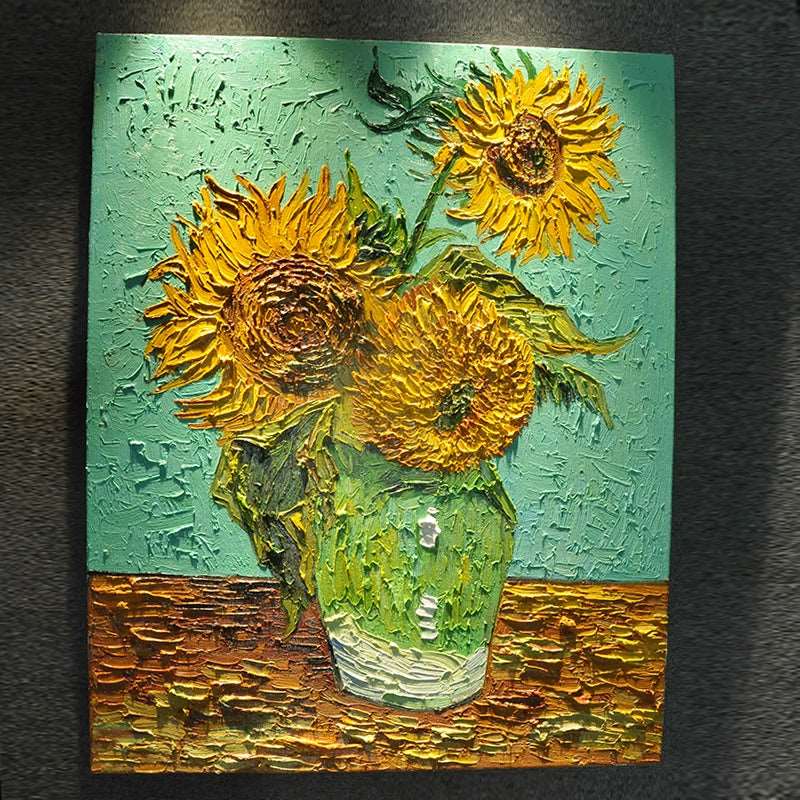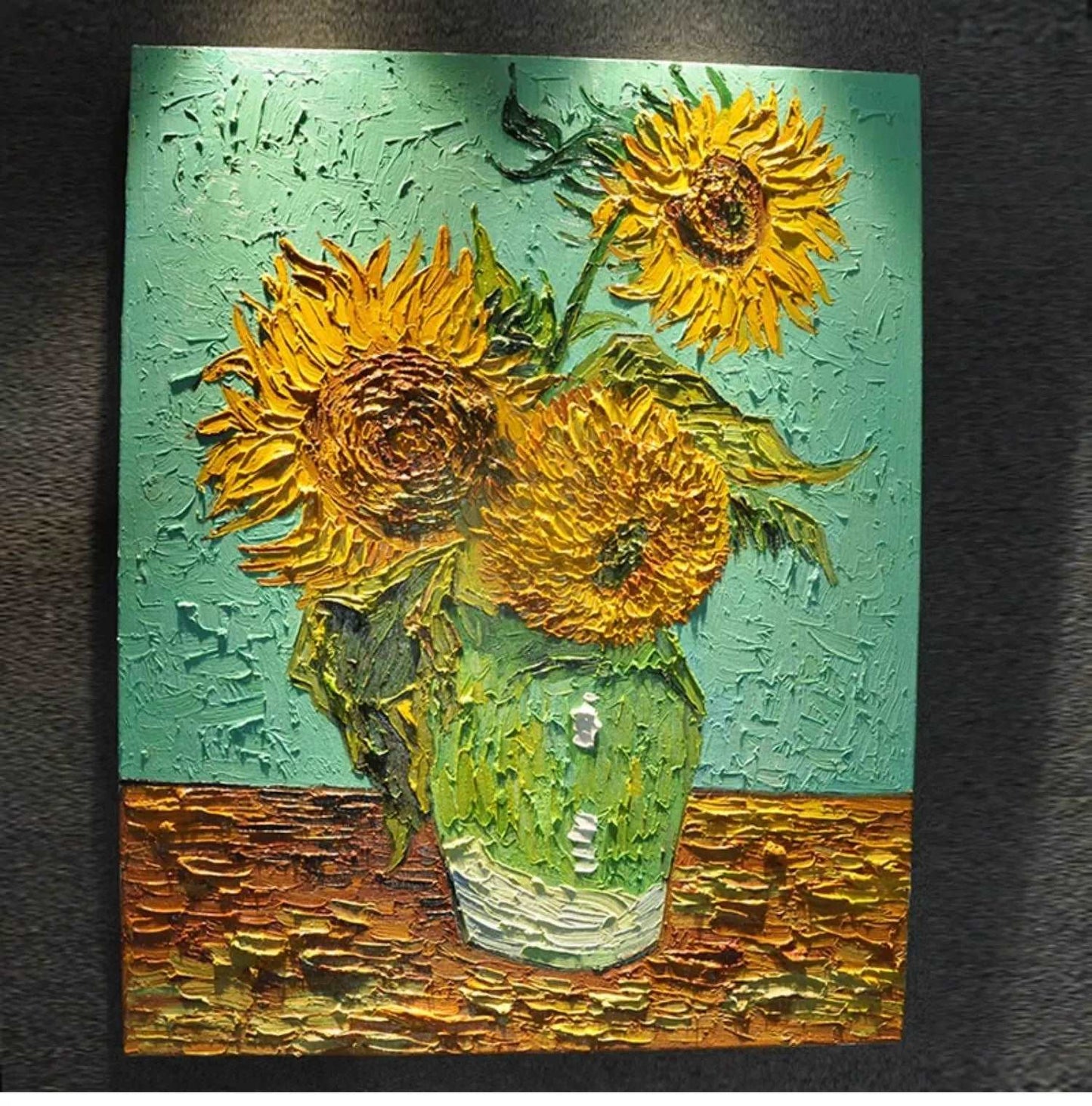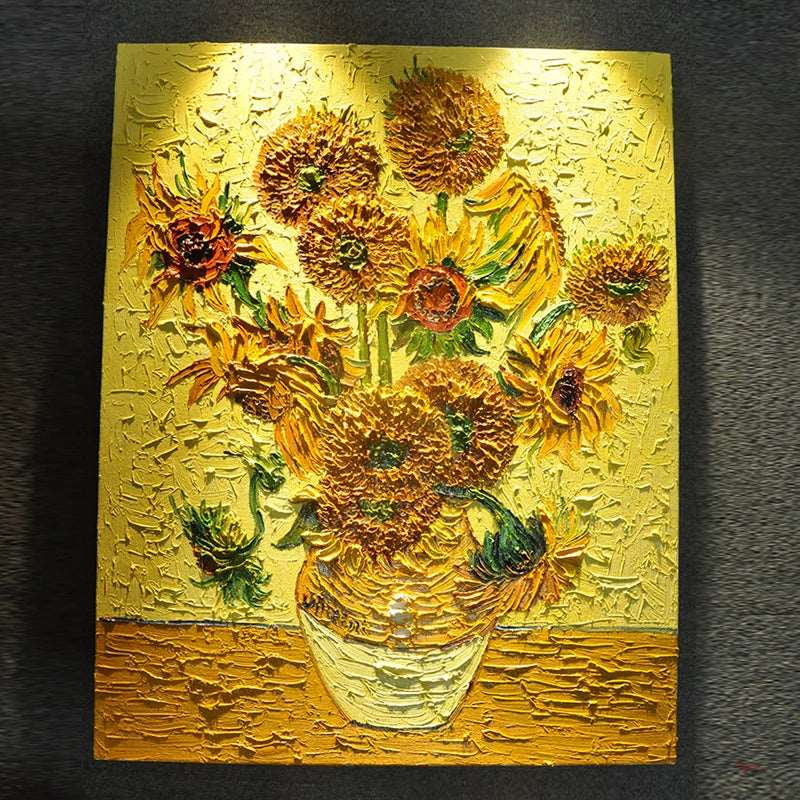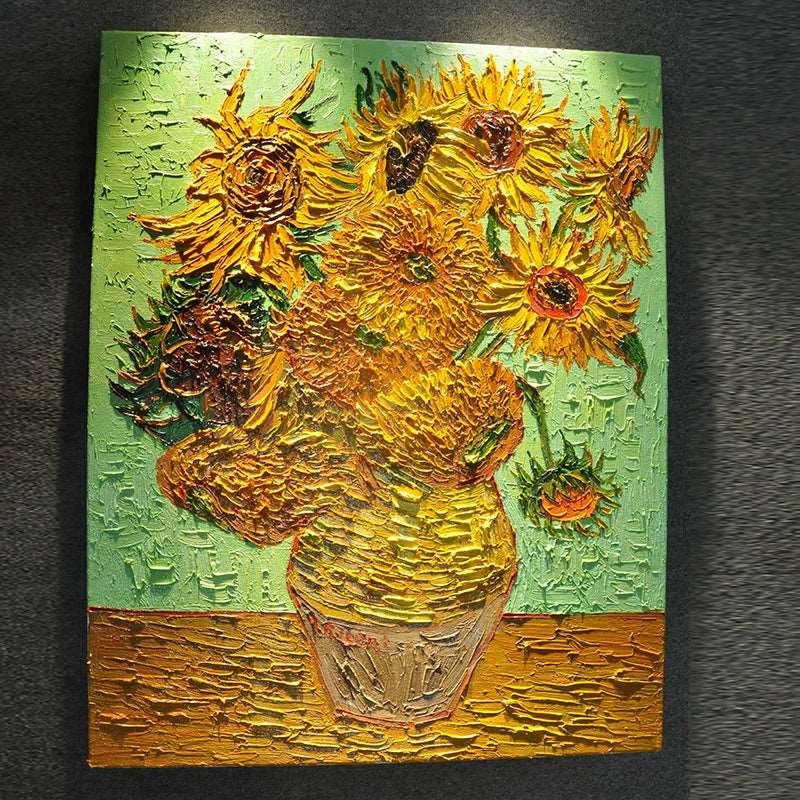- Description
- About Products
- Packaging & Delivery
The famous vase sunflower series is known as Arles’ Sunflower. This group of works was created in the summer of 1888.
Van Gogh created the painting in Arles to decorate the "Yellow House", the studio he shared with Gauguin. He wrote in a letter to his brother Theo
Now I am going to live and work with Gauguin in our own studio. I wanted to decorate it with a painting that only painted sunflowers. They paint with the same interest as the Maasai eat broth, so I wouldn't be surprised if they painted a big sunflower.
The canvases of these paintings are larger than those of previous Schutzers. In composition, many sunflowers are inserted in overflowing vases, painted on a bright background, reflecting the rays of the sun in Arles, southern France.
The first sunflower
The first work in the Al Sunflower series was created in August 1888.
The vivid depiction of the sunflower itself is very attractive, and at the same time, the yellow in the brown of the desk echoes the color of the sunflower, the bright turquoise hue, and the yellow-green color of the vase, enhancing the color of the subject.

Sunflower (F453), 1888
The second sunflower
The sunflower was purchased in 1919 by a Japan merchant named Mitsuya Yamamoto for a whopping 70,000 francs (about 200 million yen at current prices).
Yamamoto became a patron of the literary scholar Saneatsu Mushanokoji and the literary group Shirakaba-ha he led.
With the idea of establishing the Shirakaba Museum, Yamamoto purchased Van Gogh's Sunflowers and held several exhibitions in Japan.
However, the idea of establishing a museum was abandoned, and the work was displayed in the house where the owner, Yamamoto, lived in Ashiya, Kobe, but was destroyed by fire during a U.S. air raid in 1945. It is a pity that such a precious work of art was lost in the war.
Sunflower (F459), 1888, private collection of Japan, destroyed by air raid in 1945.
The third sunflower
Also known as the Munich edition, this work depicts 12 sunflowers, making it the most numerous and possibly the most gorgeous of the Sunflowers series.
Although Van Gogh's style of painting departed from Impressionism, it still retained its bold brushstrokes (tactility) with a more characteristic variation.
In the sunflowers (first) in F453, the color of the desk is rendered in brown after observing the color of the solid wood, while in these sunflowers, yellow is used, almost the same color as the petals. By using the same yellow color, the deep red color of the seeds is more potent and appealing.
Sunflower (F456), 1888, Neue Kunsthalle, Munich, Germany.
The fourth sunflower
The most famous of the multiple sunflowers is the London version. The London edition depicts 15 sunflowers.
Gauguin, who briefly lived with Van Gogh for about four months, particularly admired the sunflowers.
Like the third, this painting uses a similar yellow tone, but shows more subtle differences in the richness of colors and pigments, and is hailed as the work of the highest degree of perfection.
Probably the most frequently mentioned is this London version of Van Gogh's Sunflowers.
Sunflowers (F454), 1888, National Gallery, London, United Kingdom.
The fifth sunflower
Van Gogh's own reproduction of the aforementioned Arles Sunflower has three more copies that have been identified. This is a replica of the Munich edition (F456).
In fact, if you look closely, every flower is pretty much the same.
However, some minor changes can be seen, such as changing the color of the seeds and the outline of the vase to a more vibrant red.
Van Gogh is said to have copied his own works to decorate the walls of the Yellow House, the studio he established when he lived with Gauguin in Arles.
Sunflowers (F455), 1889, Philadelphia Museum of Art, Philadelphia, United States, reproduction of F456.
The sixth sunflower.
The work is called the Amsterdam version, and a piece of wood is added to the top of the work, probably made by Van Gogh himself.
The work is a replica of the London edition, and it is very attractive on its own.
15 sunflowers are depicted more vividly.
The work is said to have been created by Van Gogh after he was discharged from the hospital after the famous "tinnitus incident".
Sunflowers (F458), 1889, replica of F454, Van Gogh Museum, Amsterdam, Netherlands.
The seventh sunflower
This "Sunflower" is in the permanent collection of the SOMPO Museum of Art, Tokyo.
It was purchased in 1987 for a whopping 5.3 billion yen. This was the highest price for a single painting at the time.
Since Sunflowers was bought, the museum's annual number of visitors has increased eightfold compared to the previous year, which has also sparked Van Gogh's popularity among Japan.
Van Gogh's paintings may be more accessible to many viewers because they can fully enjoy the charm of the actual painting, rather than pursuing the meaning of the work based on in-depth knowledge.
Sunflower (F457), 1889, replica of F454.

At Artvora, we are dedicated to delivering high-quality, hand-painted artwork that elevates your home decor. Our carefully curated collection includes a variety of vibrant acrylic paintings, timeless oil paintings, and intricate mixed media works, offering a perfect match for every style, from contemporary wall art to classic designs.
Our team combines the innovative energy of emerging artists with the expertise of seasoned craftsmen, ensuring that each piece is a unique, handcrafted masterpiece. The slight variations in each painting highlight the authentic artistry that defines our work, making every piece truly one-of-a-kind.
We also offer a range of customization options to help you create the perfect artwork for your space. Whether it's adjusting dimensions, selecting specific color palettes, or personalizing design elements, we ensure that your vision comes to life. Whether you're seeking large wall art, abstract art paintings, or custom portraits, our goal is to provide you with artwork that enhances your home and reflects your style.
For inquiries, custom requests, or to discuss your design needs, please contact us at service@artvora.com.
We look forward to helping you create a stunning, hand-painted piece that you'll cherish for years to come.
Packaging and Delivery
At Artvora, we are committed to ensuring that your artwork arrives safely and securely. We now offer multiple packaging options to meet your needs. You can choose from the following:
Rolled: This traditional packaging method is not only safer for transport but also incurs lower shipping costs, making it more economical. It’s perfect for oil painting enthusiasts who enjoy framing their works themselves. We carefully roll your artwork and place it in a durable tube to protect its surface.

Gallery Wrap: Mounted on Backboard. If you prefer a more convenient display option, we offer the choice of mounting your artwork on a sturdy backboard. This method effectively prevents bending and ensures your artwork remains intact during shipping.

Framed: To enhance the beauty of your piece, you can choose our elegant framing option. This makes it easy to hang and adds an artistic touch to your home décor.


Each product page includes the available packaging options, allowing you to select according to your preference. Regardless of which method you choose, we will ensure that your artwork is delivered safely.
Creation and Shipping Time
The creation time for paintings may take 1-3 weeks, depending on the situation, especially for oil paintings that need time for the paint to dry. Finished paintings do not require this waiting period. Shipping time also generally ranges from 1-3 weeks, depending on your geographic location. We will use internationally recognized courier companies such as DHL, FedEx, or reliable local couriers for delivery, ensuring your artwork arrives safely.
If you have any questions about packaging or shipping, please feel free to contact our customer service team, and we will be happy to assist you.


















